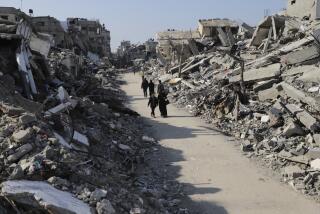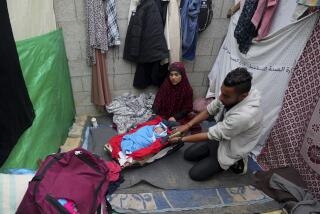Troops Tell of Street Fight With Dogged Foe
- Share via
SAMARRA, Iraq — It was the biggest urban street fight in Iraq since the fall of Baghdad. One hundred U.S. soldiers in Abrams tanks, Bradley fighting vehicles and armored Humvees had the job of protecting a convoy of Fijians delivering millions of new Iraqi dinars to two state-owned banks in this tense Sunni Triangle city.
Awaiting them were a like number of insurgents -- their Kalashnikovs, mortars, roadside bombs and rocket-propelled grenades at the ready.
As the battle unfolded over a four-hour period Sunday, with twists and turns of fortune on each side, the U.S. soldiers realized they were up against tenacious foes using their knowledge of the cramped cityscape to maximum advantage. Even small children were used as spotters by the insurgents, said 1st Lt. Jason Honeycutt, commanding one of the big M-1A1 Abrams tanks.
The engagement demonstrated at least one thing: Nearly eight months after the collapse of Saddam Hussein’s regime, anti-American insurgents are regrouping and fighting in larger numbers and more daring ways, apparently with a leadership providing coordination.
Each side has been studying the other and seeking to adapt to new threats and tactics. In the most detailed account yet of the Iraqi insurgency, Brig. Gen. Martin Dempsey said Monday that the insurgents appeared to have a central leadership that financed attacks in the capital and surrounding areas, giving broad orders to about a dozen rebel bands, some with as many as 100 guerrillas.
“I’m increasingly of the belief that there’s central financial control and central communications,” said Dempsey, who commands the Army’s 1st Armored Division, which controls Baghdad and the surrounding region.
When the Samarra battlefield cleared Monday, the new dinars had been delivered and U.S. forces claimed to have killed 54 insurgents, wounded 18 and captured 11, while suffering injuries to five of their own.
But many people in Samarra saw it differently. A hospital spokesman said that only seven Iraqis had died, while residents accused the Americans of firing indiscriminately, killing civilians and damaging buildings and vehicles.
“It was definitely a long day,” said Capt. Andrew Deponai, leader of Aggressor Company, whose tank was hit by a rocket-propelled grenade, or RPG. Deponai said the attack appeared to be “well-planned, well-coordinated.”
“They massed their forces because they wanted to make a statement,” he said.
Samarra is one of the more intriguing communities in the necklace of towns and cities strung along the Tigris River north of Baghdad. It is entered via a causeway across a dam on the river. The golden dome of its centerpiece shrine is visible for miles over a thin band of green farmland and marshes. About 200,000 people live here, many in a warren of streets and markets that surrounds the Golden Mosque, with its 9th century spiral minaret. Since the fall of Hussein’s regime, an endless stream of Shiite Muslim pilgrims from Iran have flocked to Samarra. But in its streets, a low-level struggle has been taking place, pitting pro-Hussein fighters against the police and citizens who endorse the new order. The conflict is expressed in graffiti scrawled along major streets. “Saddam -- the symbol of the Arabs” has been crossed out in favor of another saying, “Saddam -- the symbol of the cowardly Arabs.”
Until six weeks ago, U.S. forces were headquartered near the city’s main entrance. But after daily mortar attacks that killed two GIs, they pulled out to a more secure desert base about three miles away that boasts long, unobstructed views. Day-to-day security in the city has been turned over to the new Iraqi police and a U.S.-created Iraqi Civil Defense Corps, but their grip on Samarra appears tenuous.
At the entrance to the town Monday, guardsmen had olive ski masks over their faces. One said he did not want to be recognized by fellow townsmen. Also helping to provide security is a group of Kurdish militiamen, who joined in the battle Sunday.
U.S. military officials said they had reason to suspect that the convoy would be attacked, because similar deliveries had been targeted with roadside bombs. Since the banks had to be notified to expect the deliveries, U.S. forces believed their enemies would know as well.
In anticipation, said Maj. Leo Caballero, the protection force sent in Sunday was heavy, comprising a tank platoon and two infantry companies. Almost as soon as they entered the city, the American soldiers came under attack. The speed of the assault was proof that it was planned, he said. “They couldn’t get something set up that quickly,” he said.
Deponai said the first attack occurred when a roadside bomb struck an armored Humvee as the convoy was in a narrow street winding its way past the famous minaret. Three GIs were wounded, and the convoy stopped. Soldiers scanning the area spotted a suspicious van and swooped in on it. They found wires leading to the street -- apparently to detonate a bomb -- and captured the van’s eight occupants.
The convoy moved to its destination, two state banks, one a few blocks from the Golden Mosque and a second closer to the city hospital. Infantry troops spread out to protect the banks. Some moved to rooftops. Then they waited for the military police to escort the Iraqi Currency Exchange’s convoy, a slow-moving train of 20 vehicles.
That was when the fighting got serious, Deponai said. “They hit us as soon as the ICE trucks came.” Wave after wave of mortar rounds fell, said Pvt. Daryl Menninger of Illinois. “It started small and ended up like 300 degrees all around.” At one point, he said, “an RPG flew over the top of our turret and hit the wall behind us. That was a real close call.”
“It was like out of a movie,” said another private, Curtis Lawrence of New York state, who joined the Army only in May and arrived in Iraq last month.
Honeycutt and his sergeant, Alvin Ware of Texas, said the fighters appeared to be part of the Fedayeen Saddam, an elite paramilitary force used by the former government. Most had wrapped white or black scarves around their faces and could be seen shooting RPGs from behind walls and around corners. They spotted one group of attackers who had launched three RPGs. They tried to flee in a taxi. The Americans pursued, firing heavy machine guns. The guerrillas then fled on foot, dragging a wounded comrade.
Deponai said the attackers were using pickup trucks and motorcycles to move around. In teams of eight to 10 men, they kept up a steady stream of rifle fire in addition to the RPGs and mortar barrages. The soldiers, mainly from the 1st Battalion, 66th Armored Regiment, out of Ft. Hood, Texas, used tank rounds and cannon fire from the Bradleys to counter the attacks.
Despite the din of battle and the incoming rounds, the Fijians -- mostly former military men -- kept unloading their cargo, while some of their guards joined the fight, Ware said. “I have to give it to them -- those guys were on it!”
The convoy finished at one bank and drove to the second, fighting off repeated ambushes along the way. Insurgents tried to block at least one street with a vehicle to trap them, but the tanks pushed the vehicle aside.
After about two hours of fighting, Deponai said, the convoy and its armored escort started to leave. But the denouement was to come.
A separate group of four unarmored Humvees passing through Samarra had been attacked, and word came over the radio that it needed to be rescued. Several Bradleys and armored Humvees had to go back and get them. The soldiers killed three occupants of a blue BMW that was leading the attack and found rockets and rifles inside the car.
On Monday, the city seemed remarkably unscathed. Many buildings were scarred by bullets and mortar rounds, and about a dozen cars were burned, including one parked in front of the Golden Shrine. A small mosque near the hospital appeared to have been struck by a projectile.
Residents who agreed to talk seemed united in bitterness about the fighting.
Dr. Walid Faris, a hospital spokesman, said he knew of only eight people killed, including a woman leaving her job at a pharmaceutical factory and an elderly Iranian pilgrim.
“They were shooting the houses at random,” complained Kamul Agulla, standing near the burned vehicles. “People were killed. No one wants the Americans here.”
At a news conference, Col. Frederick Rudesheim was told that the tally of deaths did not match the reports of hospital officials.
Rudesheim said the Army’s estimate was based on interviews with soldiers. He suggested that the insurgent fighters may have taken away the bodies of their comrades.
“The adversary we face in this area will not bring all the casualties to the local hospitals,” he said.
More to Read
Sign up for Essential California
The most important California stories and recommendations in your inbox every morning.
You may occasionally receive promotional content from the Los Angeles Times.










